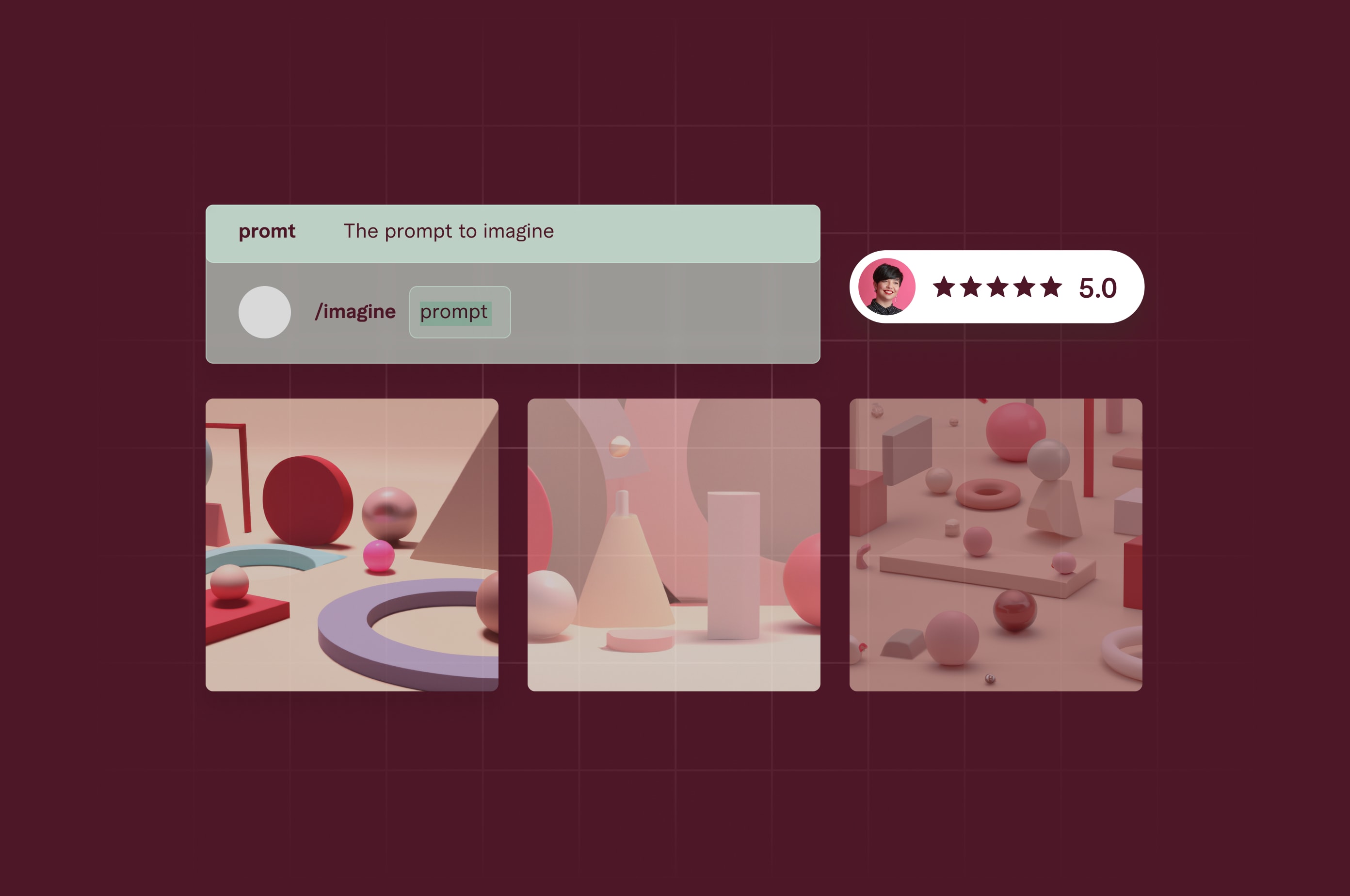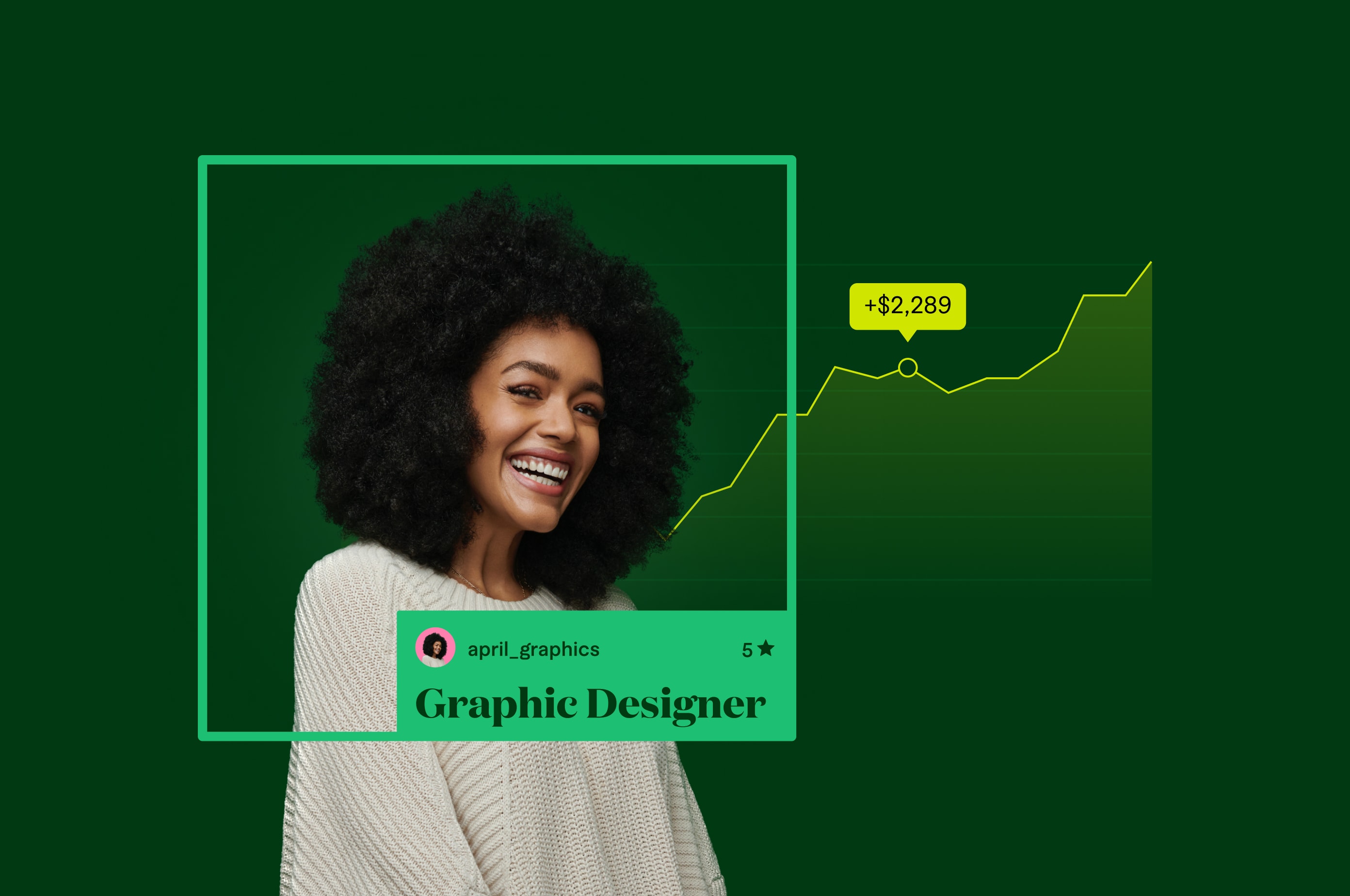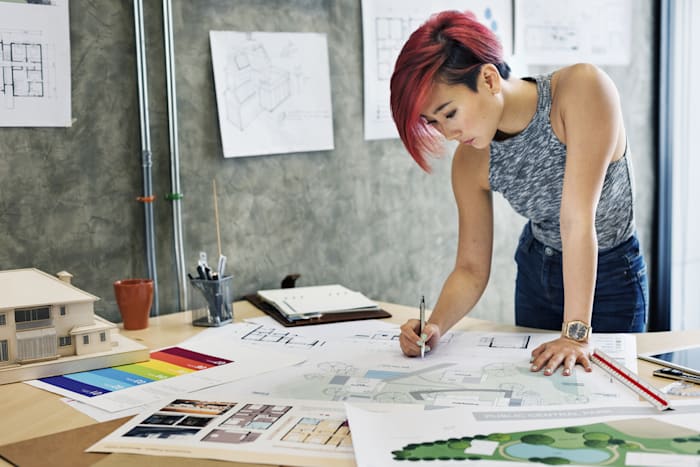How To Find and Hire an Interior Designer
Learn how to find and hire an interior designer, with tips for setting a budget, communicating effectively, and evaluating portfolios.
 September 3, 2024
September 3, 2024 6 minute reading
6 minute reading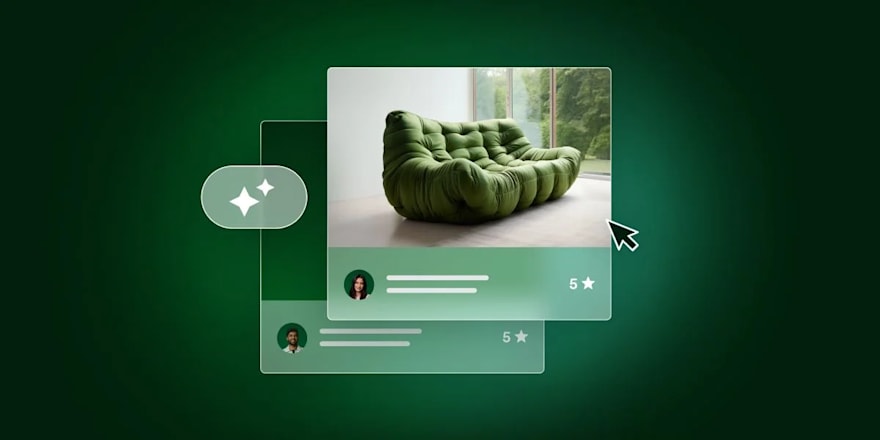
Designing a space involves many elements, and mastering the art of mixing and matching them takes time. If you don’t have a natural flair for choosing paint colors, cupboards, fixtures, and decorative pieces, the thought of it might be stressful. An interior designer can do it for you.
Interior designers offer a range of services, and the price can vary. The right person for the job will understand your style, meet your budget, and have industry experience.
This guide empowers you to find and hire an interior designer. From learning about different hiring methods to conducting interviews and making offers, you'll control the process and get the look you love.
Why hire an interior designer?
Renovating or building a home or workspace is a big investment. To ensure your project succeeds, consider hiring an interior designer. These professionals can help create a stylish but also functional and safe space.
Here are some key benefits of working with an interior designer:
Expertise: Their knowledge reduces the risk of costly mistakes.
Time-saving: They manage the details, allowing you to focus on other priorities.
Balanced design: They understand how to harmonize all elements of a space.
Timeless appeal: They can create designs that remain stylish for years to come.
Personalization: They work to understand and reflect your unique style.
An interior designer brings a holistic vision to your project. They have a knack for maximizing space without clutter, choosing complementary colors, and ensuring precise measurements. Their talent lies in creating a seamless look where everything fits just right.
How to hire an interior designer
Hiring a designer for a home renovation, new build, or commercial space is a big decision. You need someone reliable and trustworthy.
Here are the steps to take when choosing an interior designer.
Define your needs and budget
Choose a hiring method
Evaluate designer portfolios
Start the interview process
Make the offer and onboard
1. Define your needs and budget
Before hiring an interior designer, clarify your goals and the space's purpose. Differentiate between essentials (like a hidden desk in a guest room or office) and personal desires (such as exposed beams or eco-friendly features).
Consider how your location might influence the style. Coastal areas inspire pale blues and rounded edges, while urban settings suggest industrial designs with concrete and neutral palettes.
Create a mood board to visualize your style preferences, either DIY or with help from a freelancer. This will give your designer an overview of your taste. Here is an example of a mood board by designer Jess Herbert:
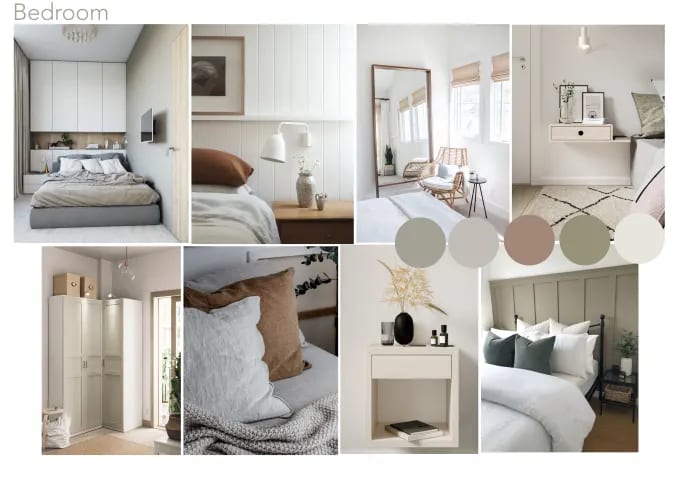
Set a budget, considering that interior designers typically charge between $50 and $500 per hour. If full-service solutions seem out of reach, consider options like consultations or planning services. You can save money by implementing the designer's ideas and independently handling the shopping and installation.
2. Choose a hiring method
Whether you're looking for a local expert or a global visionary, your hiring method will set the stage for your space's transformation. Here are the top options to consider:
Online platforms
When you use an online platform, you’ll get more choices. Fiverr gives you access to talent from all over the world, with freelancers in 550 service categories. So, if an interior designer isn’t quite right, you can look for architecture or 3D modeling services.
Fiverr has recently launched Neo AI, which has improved the search experience. You can narrow down the criteria by selecting the building type, project scale, delivery time, and budget. You can also create a brief with a description and budget and get matched to freelancers.
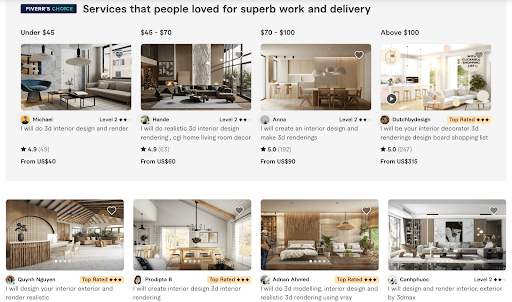
Because Fiverr has a rating and review system, you can see previous buyers' feedback before you commit. These features give you peace of mind when choosing a reputable freelance designer.
Referrals and word-of-mouth
Start with recommendations from family, friends, and neighbors. View their designers' work in person to assess compatibility with your style.
For business spaces, real estate agents and builders often have industry contacts. Explore new builds and renovations in your area. If a local shop's design impresses you, the owner might share the designer's contact information.
Social media
Most interior designers use social media to promote their work. Instagram is among the most popular platforms, with the #interiordesigner tag boasting over 25,000,000 posts.
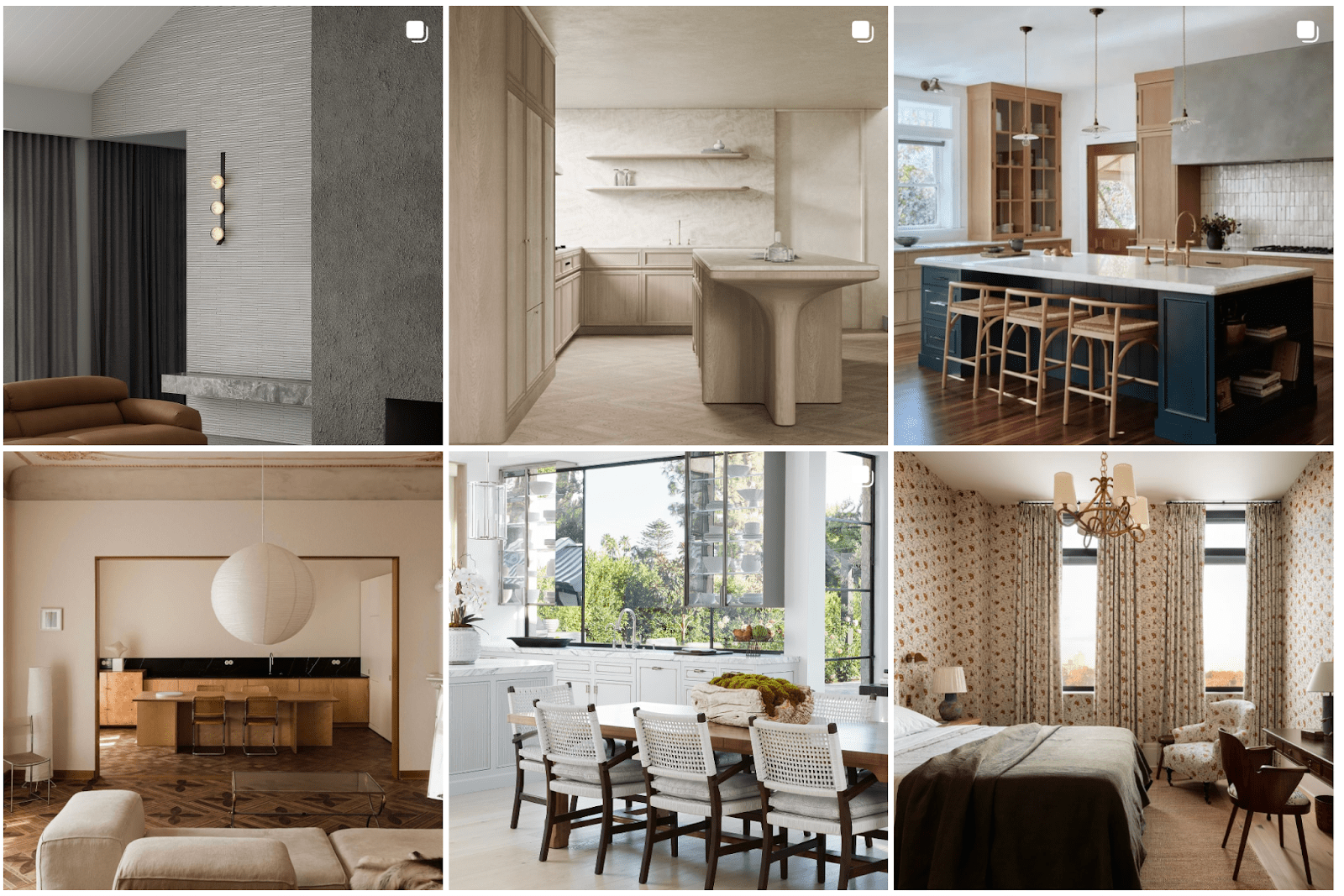
Source: Instagram
Interior design accounts get plenty of fans, too. @interiordesignmag is a standout with over 3.5 million followers.
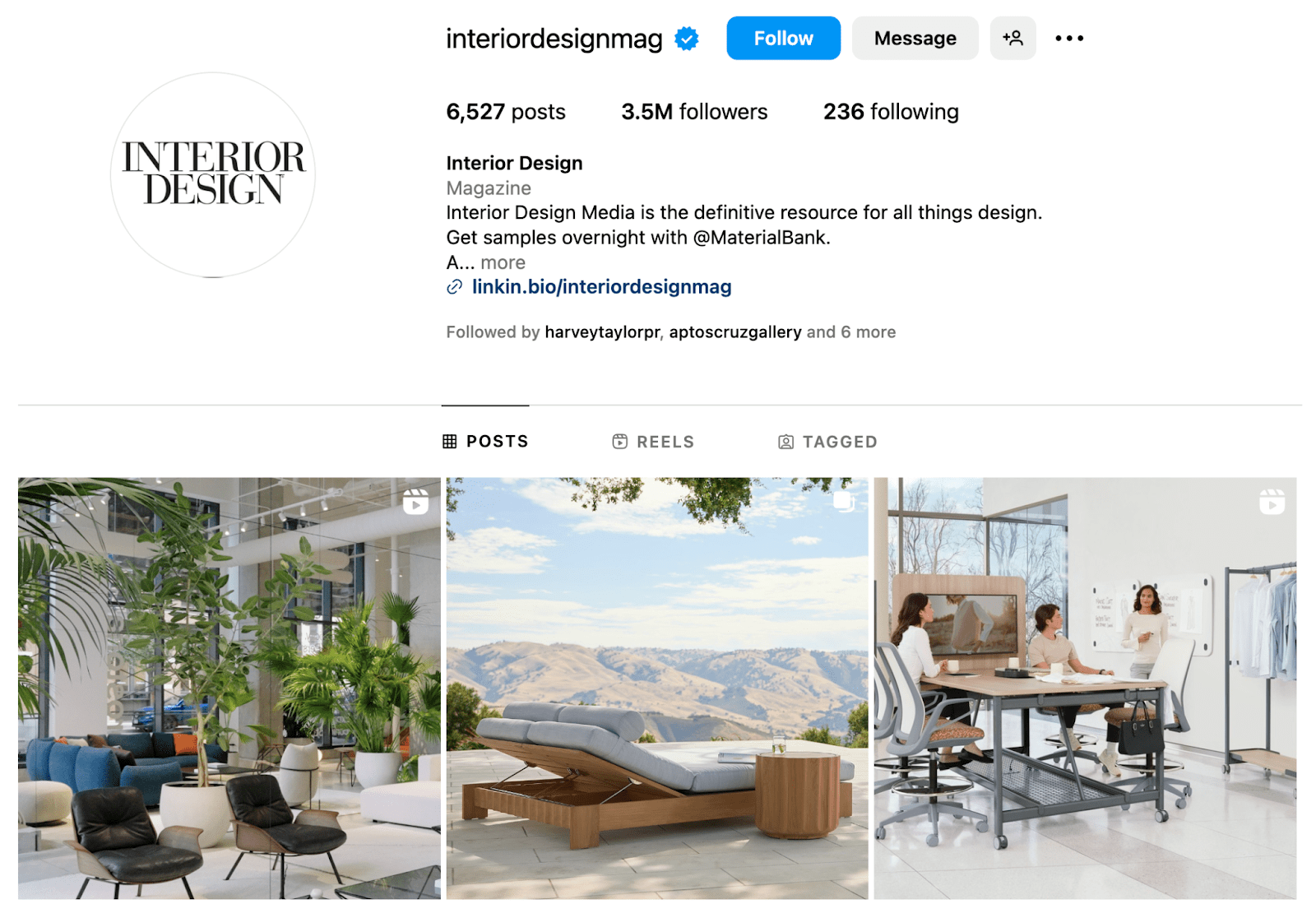
Instagram, Facebook, and Pinterest are hubs for interior designers, architects, and other creative folk. Social media can be worth a look if you’re actively searching for an interior designer or just need inspiration.
Industry websites
Professional organizations can be another useful hiring resource. Members must have a license and follow strict quality standards. They must also understand the principles of design.
Leading organizations include:
Interior Design Society (IDS)
The American Society of Interior Designers (ASID)
International Federation of Interior Architects / Designers (IFI)
The American Institute of Architects (AIA)
These networks have a large member base of qualified professionals and are particularly useful for commercial and industrial projects.
3. Evaluate designer portfolios
A good interior designer will have a portfolio with samples of their work. On Fiverr, you can use the profession-based talent catalog to search by profession, services, and skills.
Browse listings and examine portfolios to find a good match. A designer's profile is their resume, showcasing previous work, specialties, and reviews, like the Fiverr profile below.

You can see that their area of expertise is domestic properties, with rustic elements and earthy tones. If this is how you imagine your space, this portfolio may fit your brief. Also, consider the designer's background, project focus (commercial or domestic), and communication style.
Balance your budget with expectations. While celebrity designers like Drew and Jonathan Scott may be appealing, they're likely out of reach financially. Instead, find a designer who can meet your needs without causing financial stress.
4. Start the interview process
Now that you have a shortlist of interior designers, it's time to interview them. Prepare for these interviews, as they're your chance to share details about your project and determine if the designer is a good fit.
Before the interviews, have ready:
Your project type
A list of must-have features
Your budget
Your mood board
A list of questions for the designer
Here are some suggestions to get you started:
How do you approach the design process?
What is your favorite design style?
Can you show examples of work that’s similar to my project?
What are the best ways to communicate with you?
What timeline do you have in mind for this project?
Where do you source your products?
Are there any contractors you frequently work with?
Do you have any references from previous clients?
When choosing an interior designer, it's helpful to examine their portfolio of before and after photos. These visual comparisons can vividly demonstrate a designer's ability to transform spaces, giving you insight into their style and skills.

A before and after image from interior designer Michelle Wagner. Havenly
As you begin working with a designer, expect the process to be collaborative. They'll likely have questions about your space, including measurements, any constraints, and your specific needs like storage. Be prepared to discuss your brand style preferences, color schemes, and desired textures or fixtures.
Gaby from Studio NA is an expert in business architecture and interior design and a Fiverr Pro seller. She explains that "choosing an interior designer can be a tricky thing. You are trusting this person to take a look at you, your values, your lifestyle, or even your business goals and invest money into what could be a successful project."
She gives five red flags to look for when hiring an interior designer:
They refuse to hop on a free Zoom call to discuss your needs
They give you a price before asking about project needs and scope of work
They don’t ask about your goals and plans for the space They don’t create a bespoke package that includes all of your scope of work
They don’t give you detailed deliverables and a clear timeline.
You don’t have to make a final decision straight away. After the meeting, go through your notes. Don’t be afraid to ask follow-up questions if there is something you are unsure of. If you’re using Fiverr, the easy messaging system means you can chat about the project at your convenience.
5. Make the offer and onboard
Have you found the perfect interior designer? Make it official by letting them know you're ready to clarify the details, including pricing and inclusions. Like most services, there can be room to negotiate. If you're looking for ways to save money, ask if you can scale down the package.
Once you have negotiated the final details and made any revisions to the package, you can set a date for the project to start. Your interior designer will also ask you to sign a contract. It will include all of the terms of the agreement, and you should read it carefully before signing.
If you book a freelancer or consultant via Fiverr, you’ll get essential legal protection through the standard terms of service. There’s even a money-back guarantee if you’ve chosen a Fiverr Pro service. Once you’ve signed the contract, your work is (mostly) done, and you can watch the magic happen.
Interior design contracts and pricing models
There can be a range of pricing structures to choose from. The size and complexity of the project will influence how an interior designer will bill you.
A few common pricing models are:
Hourly rate: You pay for the actual hours worked by the designer.
Per room rate: A fixed price is set for each room designed.
Square foot rate: Pricing is based on the total area of the project.
Flat rate: A single, fixed price covers the entire project.
💡 Tip: If you pay by hourly rates, always get a time estimate before starting. This option can be cost-effective as you only pay for the time you need.
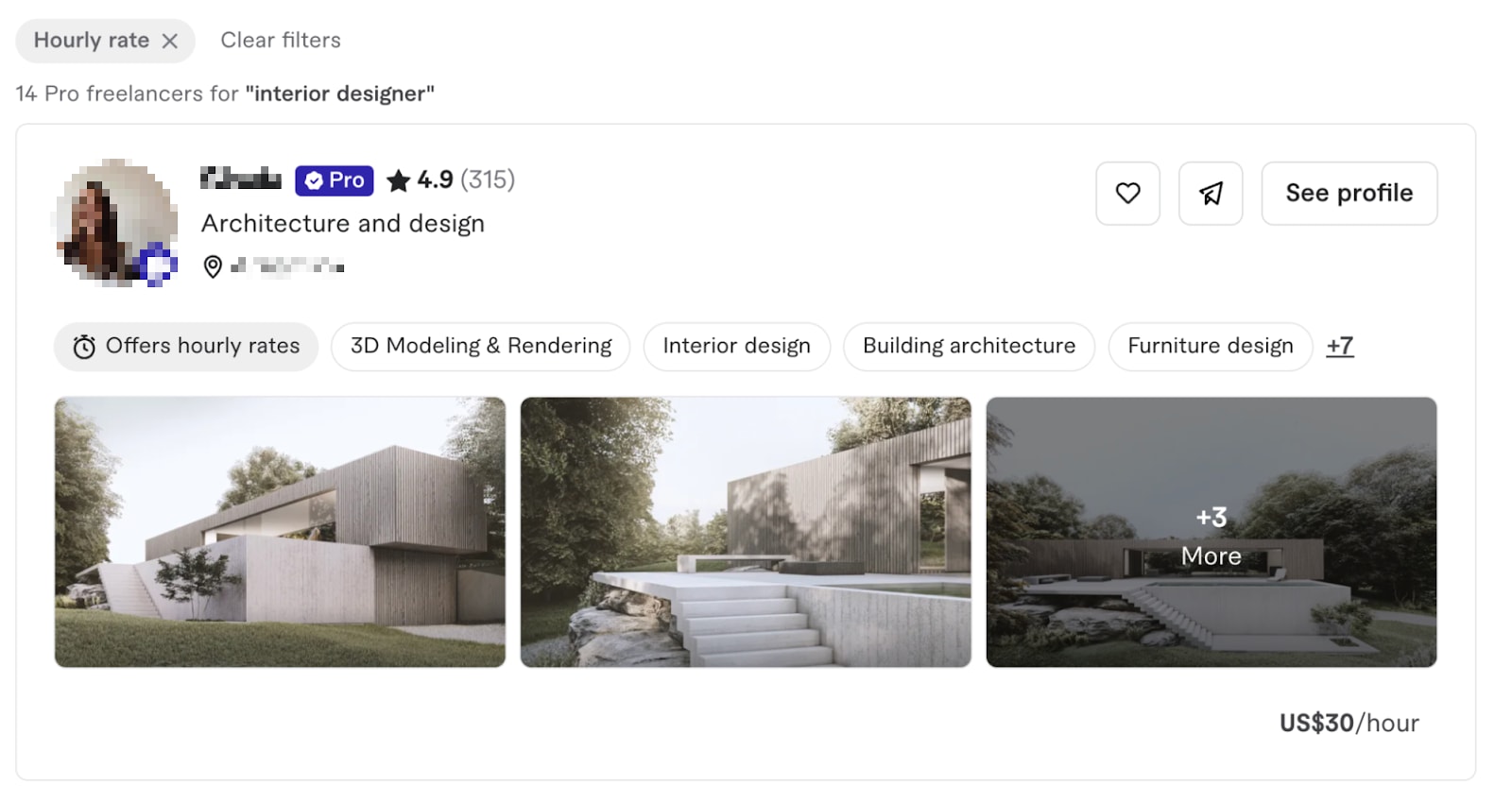
To give you more choices, Fiverr Pro freelancers have an hourly rate option. Payments made through the Fiverr platform are secure, which minimizes the risk to both designers and their clients.
There are other costs to consider. If you want to make changes during the project, expect to pay more. If you want the interior designer to purchase furniture and other accessories, you’ll need to pay for these in advance.
Of course, renovating can come with unexpected expenses. If there’s mold, the average cost to remediate it is $2,230. Asbestos is another common issue found in older homes and can cost up to $3,100 to remove. If it’s an older property, keep some money aside for unexpected expenses.
Your design contract will cover the pricing structure, rates, and payment terms. You may also notice a clause for unexpected expenses, such as “the client is responsible for any unforeseen costs.” Plus, you’ll find insurance, refund policies, timelines, and contract termination rules in the document.
Tips for collaborating with your designer
Every client is different. Some like to be involved in every decision and want a close working relationship. Others prefer to stand back and give the interior designer complete freedom. Either way, you need to be clear about your expectations if you want this to be a successful collaboration.
Make sure you have a mix of communication channels and know how to contact the interior designer if necessary. Some designers schedule check-ins to give you updates on their progress. These meetings may be in person, over the phone, or via Zoom.
When you do talk to your interior designer, use these strategies:
Be specific: Instead of giving vague feedback like 'we need more spunk,' try to articulate your vision more clearly, such as 'I'd like to see a brighter shade of green with gold accents.' This level of specificity reduces the chance of misinterpretation.
Share examples: It can be difficult to describe what you want, so try to find pictures that match your vision. Your interior designer will probably share examples and samples with you, too. For example, they may let you choose from two different tiles or multiple shades of blue.
Stay positive: You may not always agree with your interior designer, but any feedback should be constructive.
While honesty is important, design is a creative process, and no one likes to be insulted. Instead, focus on individual elements that you like and don’t like without making it personal.
Don’t have time to commit to the project? Delegate! If it's complex, Fiverr’s Business Partners can oversee the entire process.
Hire the right interior designer today on Fiverr
With the help of an interior designer, empty rooms can be transformed into functional and stylish spaces.
While there are many places you can find an interior designer, Fiverr makes choosing the right person convenient and low-risk. With detailed profiles, photographs, reviews, and a messaging system — everything is in front of you.
Ready to transform your space? Explore Fiverr's talented pool of interior designers and start your project today!
Hire an interior designer FAQ
How much should I spend on an interior designer?
The amount you should spend will depend on your budget and the interior design service provided. General advice or a 3D render will be the most affordable option. However, if the interior designer manages the whole project, it will cost a lot more.
Is it worth using an interior designer?
Interior designers can see the whole picture. They understand color theory and how to use space effectively. They may also have industry contacts. If you’re not confident tackling the design process, it is worth using an interior designer.
Is it better to hire an interior designer or do it yourself?
You can do it yourself if you have an eye for detail and know exactly what you want. However, an experienced interior designer will be up to date with the latest trends. They can give you a unique perspective and make your room special.
How much does an interior designer cost?
Hiring an interior designer can cost hundreds or thousands of dollars. The average rate is between $50 and $200 an hour, or $450 – $1,500 per room.
